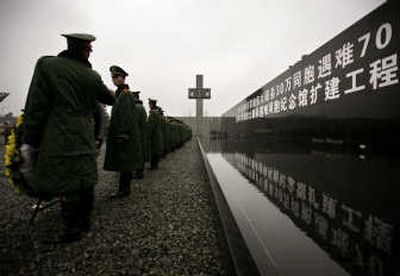Museum unites Chinese through painful history

NANJING, China – As a siren wailed across the city in remembrance of the dead, the revamped Nanjing museum opened to an expectant public with tens of thousands enduring waits of as long as two hours in the cold. Once inside, there was little time for reflection, however, as guards chided visitors to keep moving.
This month, this former Chinese capital marked the 70th anniversary of the Nanjing massacre, when tens of thousands of civilians and fleeing soldiers were killed by marauding Japanese soldiers.
History is a sensitive subject in north Asia, and this is ground zero in China’s bid to counter the small number of Japanese right-wingers who downplay or deny the mass rampage took place.
The anniversary gave China an opportunity to revamp its rather dowdy Nanjing massacre museum, placing it more on a par with Japan’s Hiroshima and Nagasaki memorials and the world’s many holocaust remembrance centers.
With growing wealth and global power comes a push to better showcase its pain and, by extension, to lay a stronger claim to history as it muscles its way into the world of global causes and ideas.
The refurbished museum is leaps ahead of its predecessor, which was badly organized and largely devoid of the personal stories that help bring history alive. The $33 million, two-year upgrade includes multimedia exhibits, survivor accounts, dioramas of bombed out buildings and a glass bridge over a partially unearthed mass grave – hardly pretty viewing, but often powerful.
As you approach the building along a sloping wall reminiscent of Washington’s iconic Vietnam Memorial, statues of victims rise out of a reflecting pool to evoke the horror even as the captions, including “flee, flee, flee” and “run, the devils are coming, run” arguably weaken the effect. The museum loses focus a bit when it broadens beyond Nanjing to cover perceived Japanese aggression extending back to the 1800s.
Japan’s reluctance to apologize for or fully acknowledge past atrocities and the high-profile official visits to Tokyo’s Yasukuni shrine by a former Japanese prime minister, where 12 top war criminals are memorialized, has rankled many Chinese. “There are a lot of different views about what really happened” in Nanjing, Mistuo Sakaba, Japan’s Foreign Ministry spokesman, said recently.
This has spurred something of a numbers game. The Chinese claim that 300,000 people were killed and 20,000 women raped in the city during a six-week period starting in late 1937 as the Japanese war machine surged across Asia. Some Japanese sources put the death toll at around 40,000. A wartime tribunal placed the figure at 142,000.
While inadequate records and wartime chaos suggest the truth will never be known, there is little evidence of ambiguity at the museum, where “300,000 Victims” signs in 11 languages dominate the entrance.
Beijing sent few central government leaders to mark the anniversary and has given muted support to memorial events. This stands in marked contrast to 2005, when it initially tolerated Chinese rioting in several major cities over Japanese textbooks.
But Nanjing, a walled city of beautiful parks and stately boulevards, is no stranger to Beijing’s changing moods. In the decades after the Communists took over in 1949, the city was discriminated against for its role as former capital of the hated Nationalist government, which fled to Taiwan.
Nanjing’s many residents from families linked to the Nationalists were persecuted in “struggle sessions” during the Cultural Revolution. The American missionaries and European businessmen who saved thousands of Chinese during the Nanjing massacre were condemned during the height of Mao’s upheaval as foreign spies. And Beijing was for many years stingy with economic development money, residents say, even as its neighbors grew rich with China’s opening to the outside world.
More recently, however, Beijing has found the city increasingly useful. “A negative can become a positive,” said Jing Shenghong, a history professor with Nanjing Normal University.
Nanjing has played a role in boosting nationalism as Communism has become a less credible ideology. “The government has emphasized Nanjing in its patriotic education,” said Huang Dahui, a professor at Renmin University in Beijing. “This helps bring people together.”